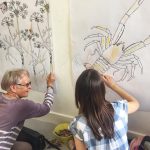Hello everyone, I’m really excited to let you know that we’ve published our second book, it’s small, handy and perfect for little ones to chuck in their rucksacks or coat pockets. It’s the eco-friendly Whitstable Seaside Guide and it is available this week!
The Horsebridge Arts Centre got in touch with me earlier this year to see if I would be interested in supporting them deliver the project. They wanted to create an interactive exhibition, run workshops and deliver an affordable and fun mini book for kids. Well we did it, the target price of £1.00 has been achieved, and the exhibition was a great success see the photos below.
The time seemed right to create a action-orientated book about Kent’s local wildlife and how we can preserve it. Recently environmental consciousness has rebounded, and it’s no longer the preserve of those that wear beanies and cycle to work, its going mainstream thanks the huge media coverage generated by the Extinction Rebellion protests, plus the popularity of Surfers Against Sewage and the #2minutebeachclean. Being into cooking, and all things food, one of our favourite pop activists right now is Hugh Fearnley-Whittingstall. We loved the work he has done regarding the Fish Fight, Food Waste and now his War on Plastic.
The Whitstable Seaside Guide is interactive, fun and informative. Children are helped by Daisy the Diver to find and learn more about the more common plants and creatures that live on Kent’s beaches including very rare animals like the Fisher’s estuarine moth. Each species included in the guide features a line drawing to help with identification, each drawing can be coloured in when the plant or animal has been located using the included map.
The Whitstable Seaside Guide is printed using sustainable paper and ink and is exclusively available for £1.00 in The Horsebridge Arts Centre Shop. Budding conservationists and artists are encouraged to learn more about the local flora and fauna, art therapy and ultimately mindfulness through the book. All proceeds generated from its sale will be re-invested by The Horsebridge into its programme of community arts projects. I’d also like to take a quick moment to thank our project sponsors The Cleary Foundation and Brett Aggregates, without their help, none of it would have been possible.
The post The Whitstable Seaside Guide launches this week appeared first on YogaWellbeing.co.uk.










In the past 5-6 years there have been many books on the best sellers list tackling the topic of creativity and how good it is for us to tap into our own innate ability to sing, write, dance or paint, not to mention a bunch of other things. Titles like Big Magic: Creative Living Beyond Fear, have sold by the boat load, but are people really applying what they have read about, and why should they? What’s the upside? Inevitably as we always do with such things, we must look to scientific research and its findings for the details….Not going into this too deeply, here are four ways creative activities can boost your health and why:
1. Write Away Your Woes
Writing about difficult or emotional events has been found to result in positive changes to physical and mental health, in non-clinical and clinical studies. Those engaging in expressive writing are asked to develop this text for 15–20 minutes on 3–5 occasions. People who do so have consistently shown more desirable physical and psychological outcomes compared with those who write about other more neutral topics. This finding was upheld in a meta analysis of over 400 individual studies in 2006 by Joanne Frattaroli.
2. Paint Over Anxiety
Whether you’re creating it or just enjoying looking at it, visual art has a big impact on the human brain. Neuroscience tells us that when we looking at art, the parts of the brain involved in processing emotion and those that kickstart our pleasure and reward systems are all being engaged. The Influence of Art Making on Anxiety: A Pilot Study has also revealed the psychological effects of creating art. It can significantly reduce a person’s state of anxiety and has led to conversations about the use of art therapy to help students deal with stress.
3. Singing for Health & Happiness
Singing is known to help performers breathe deeply and also correct posture. But a 2016 study involving the Royal College of Music in London suggested that it may boost immune system activity as well. The study tested nearly 200 members of different choirs who were affected by cancer – either caregivers or diagnosed with the disease – by collecting samples of their saliva before and after an hour of singing. Results showed a significant reduction in stress hormones and an increase in proteins, like Cytokine, which help the body fight illness. This is amazing news and another reason to crack up your favourite tunes on your journey into work, maybe not if you take the train though!
4. Dance Your Way To A Fitter Mind
Most peoples visit to the Gym involves them following a very structured work out plan designed to achieve certain objective(s); further more the individual exercises often taking place on specialised equipment do not allow much scope to go off-piste! Dancing on the other hand is completely different, it provides freedom in terms of movement and speed, it is also inexpensive or free, and can be enjoyed alone or in a social setting. Dance like other activities such as yoga and swimming involves moving every part of your body, and can do wonders by improving muscle tone, cardiovascular health, balance, coordination and a whole lot more. A large scale 2003 study which analyzed a variety of leisure activities suggested that dancing was “the only physical activity associated with a lower risk of dementia”.
The post 4 Ideas For Tapping Into Your Creativity & Boosting Your Health appeared first on YogaWellbeing.co.uk.










There have literally been thousands of studies investigating the health and wellbeing effects of drinking coffee over the past few decades. Lately more and more are reporting significant health benefits from drinking a regular cup if Joe. However, possible gains should weighed up against the potentially bitter effects of the drink:
Why Coffee is Bad
1. Babyccino – Who Wants An Anxious Baby?
The National Health Service says it’s safe for pregnant women to drink a moderate amount of coffee (no more than 2 cups of coffee per day), but warns that it’s still not clear if higher intakes could increase risk of complications. If you consider the effect that coffee has on blood pressure its probably best to listen to this advise. High blood pressure markers are big no no for mums to be.
2. Doing The Jitterbug – Caffeine Tension
Some people are more sensitive to caffein than others, in these cases it can cause irritability or anxiety, so how does this happen? Well on a micro biological level, lets not go too deep… caffeine binds to adenosine receptors on nerve cells, leaving no room for adenosine to get in this causes nerve cell activity speeds up, blood vessels constrict and sometimes people get irritable jitters. If you are regularly to be found around the Nespresso machine in the office you’ll likely develop tolerance to its effects and the jitters will subside. But that also means that eventually you’ll need a regular caffeine fix just to reach your baseline level of alertness. The knock in effect of knocking black all that black stuff is that your body will adapt by producing more adenosine receptors, making you more sensitive to the effects of adenosine. So if you don’t have your daily cup, you’ll may develop withdrawal symptoms like extreme fatigue and headaches ouch!
3. Another Bad Nights Sleep? You’ve Had Beanough!
If keep finding yourself waking up feeling like you had a rubbish nights sleep if might be time to change what you drink rather than your mattress. Some studies have shown that even having one regular serving of coffee within six hours of bed time can reduce time asleep by at least one hour. The effects on quality of sleep may be worse.
Why Coffee is Good
1. Steady Blood Sugar Levels
Some studies have linked frequent coffee consumption with a lower risk of developing type 2 diabetes. Scientists suspect that compounds found in coffee—cholorogenic acid and quinides—may increase cells’ sensitivity to insulin, which helps regulate blood sugar. The flip side of this is that most of us like a slab of cake with our cuppa, or at least one of those chewy biscotti’s.
2. Déjà brew – Beating Dementia and Alzheimer’s
Drinking Coffee regularly may help reduce the risk of dementia and Alzheimer’s disease, as well as Parkinson’s disease, studies suggest. How does this work? Some of the antioxidants found in coffee may prevent damage to brain cells and boost the effects of neurotransmitters involved in cognitive function, say experts. Early studies have noted that as coffee (or tea) intake rises, incidence of glioma, a form of brain cancer, tends to drop. Some researchers speculate that compounds in the brews could activate a DNA-repairing protein in cells—possibly preventing the DNA damage that can lead to cells becoming cancerous.
3. A Hearty Cup
Some research indicates that moderate coffee drinkers (1 to 3 cups/day) have lower rates of stroke than non-coffee-drinkers; coffee’s antioxidants may help reduce inflammation’s damaging effects on arteries. Some researchers speculate that the compounds might boost activation of nitric oxide, a substance that widens blood vessels (lowering blood pressure). However like your mum used to tell you (well mine did anyway) all thing in moderations): a 5-cup or more daily habit is associated with higher heart disease risks. Researchers believe excessive caffeine may sabotage the antioxidants’ effects.
What do you think? Please let us know in the comments!
If you think you are drinking too much coffee, but are struggling to ween yourself off, feel free to get in touch. We offer digital mindfulness courses, which can help you to change / form new habits. We also offer private consultations via video call.
The post 3 Reasons Coffee Is Bad For You (+ 3 Reasons Why It’s Good) appeared first on YogaWellbeing.co.uk.










There are lots of reasons why we should continue to buy things like yoga mats from shops rather than ordering everything online:
- For some purchases its nice to touch them and get a feel for what they are like in real life
- On other occasions you need something there and then and can’t wait for a delivery
- You may want to buy quite a few, i.e. a number of yoga mats for friends of family, often when buying on line this would generate significant delivery charges. Particularly if the item is quite large
The following are a list of shops in and around the Whitstable area that stock yoga mats either permanently or on occasion.
1. The RSPCA Whitstable
Where: 67 Oxford St, Whitstable CT5 1DA
When: Being a charity shop they don’t stock yoga mats as standard. But being London-by-sea they do come in. You can call ahead of time if you don’t want to waste a journey (01227 264609).
Cost: £various
2. Mountain Warehouse Whitstable
Where: 51 High St, Whitstable CT5 1AP
When: Anytime really
Cost: From £4.99, you may need to order into store (call to 01227 266020 to check)
3. Aldi Whitstable
Where: Estuary View Retail Park, Whitstable, CT5 3SD
When: Aldi stocks non-food items on a seasonal rather than permanent basis, but they have stocked yoga mats in the past. you can check by visiting the special buys page on their website.
Cost: £Cheap
4. DW Sports Canterbury
Where: Maybrook Retail Park,, Kent, CT1 1 ZG
When: If you can make the journey into Canterbury this store is the nicest one, that will most likely have a mat for you to pick up there and then. Though you are unlikely to have many choices of colour etc. Call ahead on 01227 478 980.
Cost: £19.99
5. Sports Direct Canterbury
Where:Stour Retail Park, Canterbury CT1 1AD
When: Anyday, we have not checked this store for a while, but the company sells quite a few mats online. Call ahead on 0344 332 5230
Cost: £Cheap
6. Go Outdoors Canterbury
Where: Wincheap Industrial Estate, Maynard Rd, Canterbury CT1 3RH
When: Anyday, they don’t specifically sell yoga mats though, they sell foam sleeping mats. These are effectively the same as cheap yoga mat, so its a good option if you are desperate
Cost: £Cheap
7. Decathlon Lakeside
Where: Tunnel Estate Retail Park, Weston Avenue, London RM20 3LP
When: Anyday, Decathlon sell a range of Yoga Mats and usually have quite a few in stock, they also have plenty of outfits, yoga socks etc to choose from.
Cost: from£5.99
The post 7 Places To Buy A Yoga Mat Near Whitstable appeared first on YogaWellbeing.co.uk.










Living on the coast has many perks, the fresh air, beautiful sunsets, not to mention the calming sounds of the ocean. Unfortunately most folks choose to stay indoors for much of the day and miss this stuff. Who can blame them, with Love Island, Versailles and other mush like Game of Thrones, its a good escape from Trump, Brexit etc in the News! Anyhow, getting back to the point, quite a few of our local Whitstable students have been getting in touch asking for our recommendations on where to practice yoga and meditation in the great outdoors around town. We decided to pull together this short-ish blog post to help them out, these are our favourites, admittedly not all free, but we did say “best”.
1. The Beach At The Battery
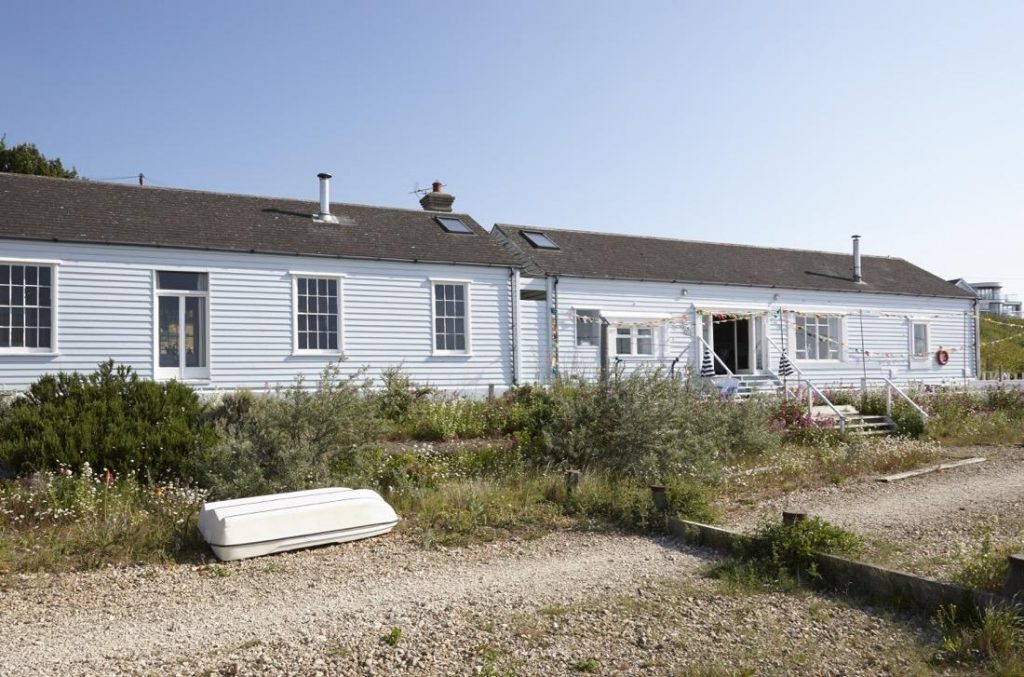
The Battery is a large wooden building about 1.5 miles walk away from the centre of Whitstable. It was originally built to house sailors training to use firearms, when it became surplus to those requirements it was converted into a convalescent home for those same sailors during the First World War. Many years later, the building and land were bought by the Shaftesbury Society, a charity that provided seaside holidays for children with disabilities, and all together more friendly vibe. The Battery was the perfect location for this kind of work, given its proximity to the water. In the late 90’s it was sold again to a private buyer, who now runs artists retreats there. The beach in and around the house is private, but it is perfectly possible to setup near the waterline without disturbing the owners. In most cases the stones on the beach will not make a great base to place a mat to do asana, but a blanket should be fine for sitting and meditating. What a lovely spot to practice yogic breathing!
Where: The Battery can be reached by walking along the beach front from The Old Neptune. Along the way you will pass the Whitstable Tennis Courts, Peter Cushings House, Wave Crest (a terrace of large colourful Victorian houses), beachuts, a caravan park, and more houses. The walk is lovely and if you enjoy beach combing you’ll be in for a treat. Loads of beautiful pebbles and shells sift through!
When: mid-afternoon would be best, with the chance to catch the sunset and the local rabbits coming down onto the beach to watch it.
Cost: £free
2. Onboard Greta The Thames Sailing Barge
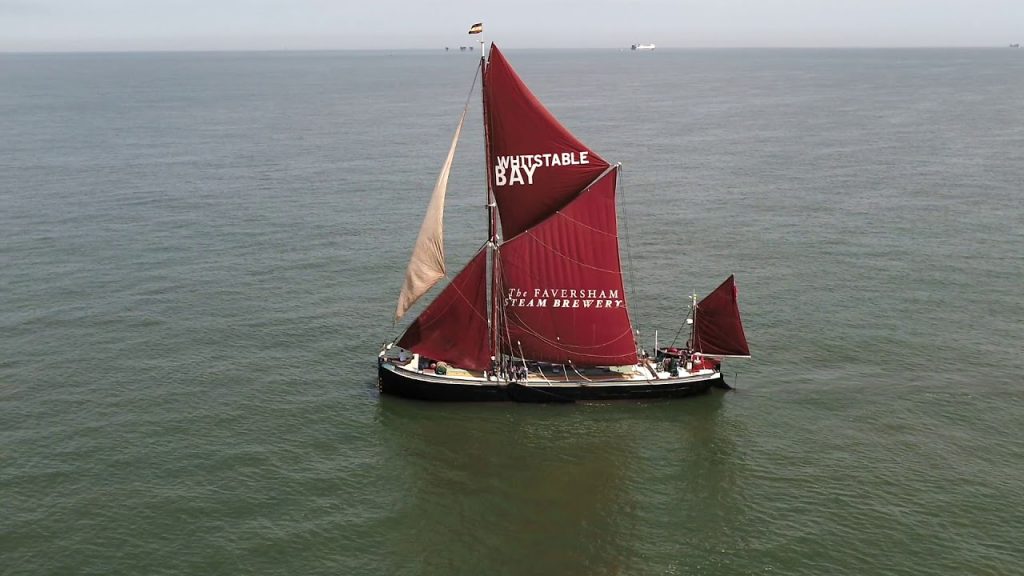
Greta is a Thames Sailing Barge built in 1892 to be used as a working barge transporting cargo on the River Thames and the Thames Estuary. She carried ammunition, beer, grain, malt and building products. Although Greta no longer carries cargo she still plies the waters in and around Whitstable Harbour. ‘Greta’ is listed on the UK National Historic Ships Fleet Register. She took part in the evacuation from Dunkirk in 1940 and is the oldest Dunkirk Little Ship that is still working today.
One of Greta’s most popular trips is to visit the Second World War army forts designed by Guy Maunsell. The Forts can be seen from Whitstable and Herne Bay. Another trip Greta regularly makes is to sail up the River Swale, under the Kingsferry Bridge to see the infamous wreck of the USS Montgomery off the Isle of Sheppey. Whilst there, the boat often draws the attention of seals and seal pups in the vicinity.
Where: Greta operates out of Whitstable Harbour from Spring (April/May) till late Summer (Sep/mid Oct). The best place to meditate appears to be towards the bow as Steve Norris’s two lovable dogs, which go out on each trip tend to stay near the stern where their kennels and Steve are located. If you bring a mat or blanket make sure it is heavy or weighed down, its easy for things to blow over the side, even though the boat does not go that fast!
When: Greta generally sets sail as the tide is coming in an often around midday, as the trips last approximately 6 hours, so you return for early evening. Don’t forget a packed lunch, the crew provide hot drinks.
Cost: £48 per person
3. Onboard a Stand Up Paddle Board
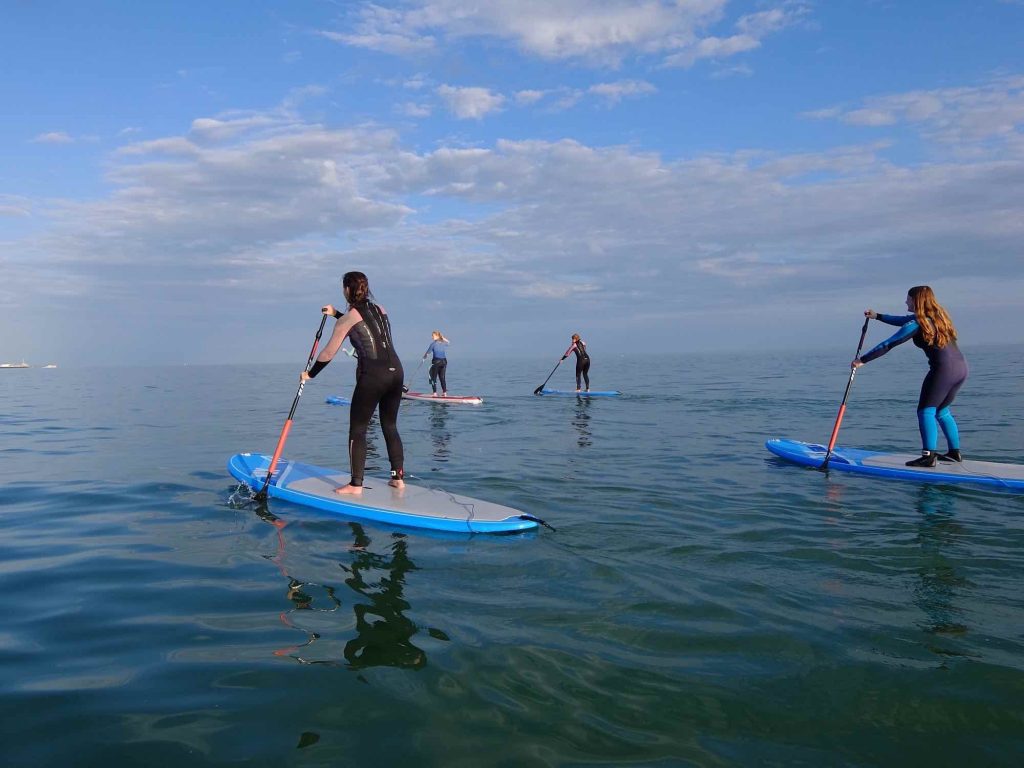
Stand up paddle boarding is a natural complement to Yoga, the sport itself is hugely helpful for developing core strength and balance, whilst the board itself, if you have a large one, makes a fantastic yoga mat if conditions are favourable. In Whitstable, stand up paddle boards can be rented from Oyster Coast Watersports by the hour, these come with a buoyancy aid and a wetsuit if required.
Where: Oyster Coast Watersports operates out of Longbeach in Whitstable. Longbeach sits to east of Whitstable harbour and can be reached by following signs to the Lobster Shack / East Quay venue. The Oyster Coast Office is part of the Whitstable Sea Scouts Compound.
When: The best time to hit the water will be in the afternoon when the sun has moved a bit further around the sky, you’ll also want to be out when tide is on its way in. This way it is safer and you will not need to walk the board out across the sand and mud.
Cost: £15 per person per hour
4. The Street
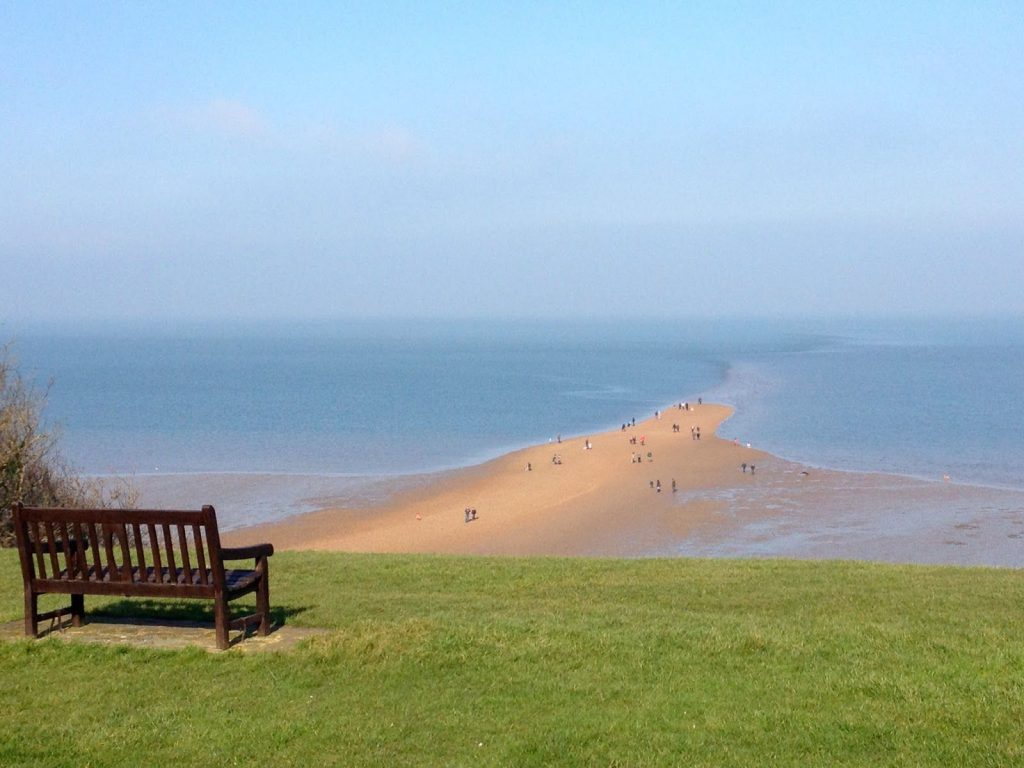
The street is a half mile long shingle ridge reaching out into the sea below the Tankerton Slopes. It has been a prominent feature at low tide for hundreds of years, but its origin has been the subject of much speculation. Some suggest a Roman road (random) or a low tide jetty (unlikely given its large size). It is far more likely to be a natural feature resulting from the interplay river and tidal currents, a net result of longshore drift. The resulting accumulation has developed out at sea to right angles to the shore, until it meets Thames Estuary currents that cause it to turn slightly eastwards.
Where: from whitstable town centre follow the road to the harbour walk around it and head for the coast path that you can pickup outside the Hotel Continental. Then keep walking for 250 meters until you get to a house called The Beacon House on your right. When you do, turn left and look out to sea, If the tide is out, the Street will be in front of you. The best position to get some peace should be right at its seaward tip.
When: just before low tide, this is when the waters unveil the Street in all its magnificence. Even better a low tide at sunset, in the summer, the mighty sun falls over the Isle of Sheppey, and The Street provides a brilliant viewpoint for this.
Cost: £free
5. Long Rock
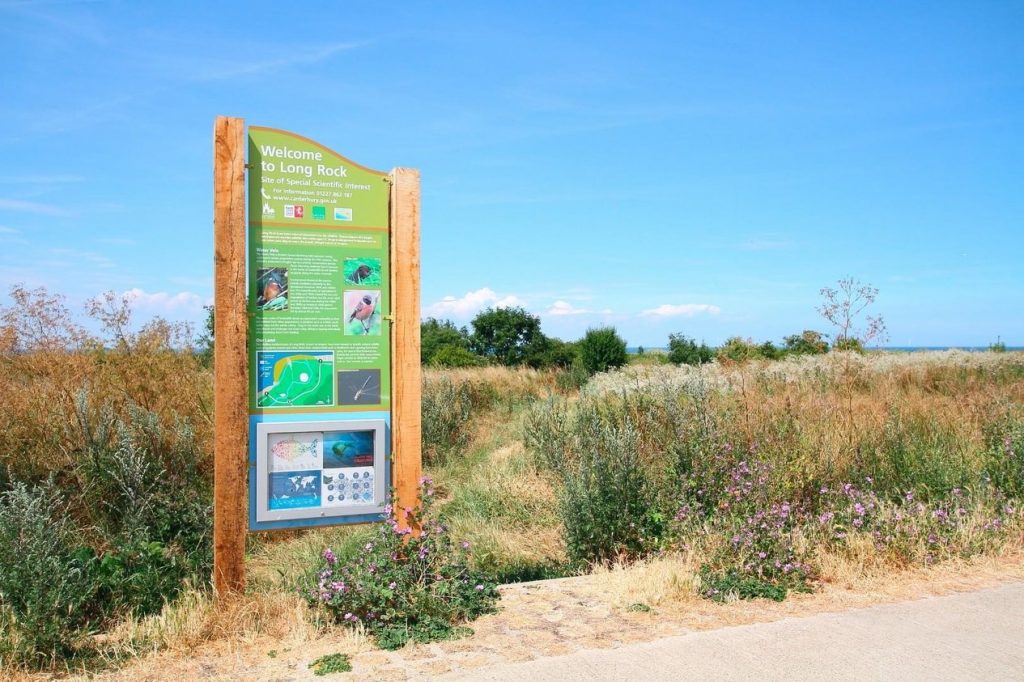
Long Rock, located between Whitstable and Herne Bay, is part of an internationally significant coastal zone, the Thanet Coast and Sandwich Bay. Long Rock marks the point along the coast that the Swalecliffe Brook empties into the sea. Swalecliffe Brook actually starts in the the ancient Blean Woodlands before heading north across country. On the site of Long Rock there is a 400 metre wide shingle spit that has developed across the mouth of the Swalecliffe Brook, diverting it westward towards Tankerton Bay. The area is very popular with twitchers, but don’t let that put you off! They are here for good reason, up to 160 bird species have been spotted annually over the past decade. This is a wonderful spot for walking meditations in Whitstable
Where: As with the Street, from Whitstable town centre follow the road to the harbour walk around it and head for the coast path that you can pickup outside the Hotel Continental. Then keep walking for 2 miles until you get to skatepark on your right. When you do, turn left and look out to sea, Longrock is in front of you. The best position to get some peace away from cyclists and other pedestrians is to head to the Herne Bay side, cross the bridge, and then double back towards seaward side
When: just before high tide, it always looks nicest when the tide is in there
Cost: £free
The post The 5 Best Places to Meditate Outdoors in Whitstable appeared first on YogaWellbeing.co.uk.










Hello everyone, I’m really excited to let you know that we’ve published our first book. It’s big, bold and bound to get your creative juices flowing. It’s the colourful Whitstable Colouring Book and is available now!!
Whitstabubble (as it’s referred to by the locals) is well known for it’s high street full of independent shops, seafood restaurants and micro pubs. I moved here with my family for the stunning orange smartie sunsets, fresh North sea air and relaxed way of life. Living here day to day deepens your connection to the sea, if your going out on the water everyday you become more aware of the tides and moment to moment changes. When I practiced my outdoor yoga I started to notice that more plastic was getting washed up on the shore. The local wildlife was effected and I couldn’t stay in down dog for the rest of the day. However big or small a gesture I needed to do something about it.
The town is full of artists, musicians and other creatives… You don’t have to try very hard to find a talented singer songwriter playing their music around town at the weekends, we also have a bunch of fantastic festivals to enjoy including the soon to start Whitstable Biennale a festival of art, performance, film and sound running from Saturday 2nd – Sunday 10th of June 2018.
To coincide with this years event I have launched The Whitstable Colouring Book!!
Art can be used as a tool, or at least a process to connect and maybe even understand our unconscious selves. I would love to see more kids doodling and colouring. As a trained art therapist and yoga teacher I have seen the positive impact this relaxing practice can have on the lives of both children and adults alike.
I created The Whitstable Colouring Book to create engaging graphic materials to support the work that I have created with my art therapy clients. I was surprised to find that nobody had put together a Whitstable colouring book. The five or six pages of marine animals I started out with, seemed to take on a life of there own and turned into eighty pages covering Whitstable landmarks, seaside myths and legends and sea creatures.
The Whitstable Colouring Book is printed on 100% recycled materials, retails for £10.00 and will be available to buy both online and from independent retailers during and after the Biennale. Budding artists and casual colouring fans are encouraged to learn more about the history of Whitstable, art therapy and ultimately yoga through the book. Ten percent of all proceeds generated from the sale of the book will be donated to Sea Shepherd UK.
The post Whitstable Colouring Book Now Available!! appeared first on YogaWellbeing.co.uk.










There are many different places that you can buy a yoga mat from, and many different brands to choose from. The choice increasing exponentially based on how large your budget is. At Yoga Wellbeing HQ, we feel however that price should only form part of your decision making process, even if you do have less money to spend. The main reason being the environmental impact each new yoga mat has on the environment. Cheap yoga mats are often made from PVC which generally contains phthalates, pronounced “thalates”. Phalates make plastics more flexible and bendy, but they have been linked to health issues and negative impacts on the environment, the main one being chemical emissions over the products lifetime – even in your home. Plastic in generally not that biodegradable either, so if you love yoga, and love our little planet, its best to save up a bit longer and skip the PVC mats. The other materials you may see online or in shops are: TPE (Thermoplastic elastomers) and PU (Polyurethane), whilst easier to recycle than PVC, neither biodegrades that easily as the products themselves are made from processed materials involving chemical reactions. So whats the answer?
Environmentally friendly yoga mats
Thankfully there are more environmentally friendly yoga mats out there, some are made from naturally occurring materials like cork and rubber, whilst others are made from recycled materials such as soft drinks bottles. There are even companies that have combined the best of both materials, using renewable natural materials and combining them with recycled. Yoga Design Lab is an example of a business which has followed this approach.
Yoga Design Lab
The idea for Yoga Design Lab started with the founder Chad Turner visiting in Bali and attending a yoga class full of uninspiring chemically made yoga mats. This was his light bulb moment. Believing that there must be a better way, Chad sold everything he owned and moved to Bali to surf and design yoga mats, and the rest as they say is history.
The Combo Mat
Yoga Wellbeing has had plenty of requests over the year’s for a non slip, eco (chemical are a big no no) and durable yoga mat. We’ve looked high and low for the right balance between all these elements and have found it in Yoga Lab’s stunning range. Whilst looking stunning in virtually all designs, the different mat formats including studio, commuter and travel all try to utilise sustainable natural materials, whilst the images are reproduced using water-based ink. They tick all our tree hugging boxes!
Our favourite format of all is the Combo Mat, this acts as both a mat and a yoga towel in one and folds up really easily in your suitcase. It combines a lightweight 3.5mm biodegradable tree rubber mat with an absorbent top layer in a whole range of wonderful peaceful and playful designs. It is even machine washable, which is handy as the microfibre finish can pickup more stains. Grip is simply fantastic, particularly if used in a hot country like Spain when you may sweat a little more. Yoga Design Lab recommend using an atomiser to spray dusting of fresh water on this mat before you start – maybe enthuse with your choice of essential oil!
Size & Weight
- 178cm x 61cm x 3.5mm
- 1.8kg
The post Review: Yoga Design Lab Combo Mat appeared first on YogaWellbeing.co.uk.










Its not everyday you get to walk down to your local cafe and interview an internationally acclaimed philanthropist, author and Buddhist nun. Being a yoga teacher I have to admit that I have been looking forward to this meeting Emma Slade for sometime. I already knew that she was a keen yoga practitioner, and that in its way, it has played a part in her finding the Buddhist way. I also knew that Emma had not always been on this path, so was looking forward to the insights she could provide, having had the experience of living as a lay person (Investment Banker) too.
I don’t normally like to grab a coffee in Costa, there is nothing much wrong with it taste wise, its just that I prefer to support the local businesses in and around Kent. However the Costa Coffee in Whitstable, (where I teach teach yoga) and where I found myself for this interview feels different, more homely, more Whitstable really.
Having not met Emma Before, I wasn’t really sure what to expect. This is not the place to discuss her back story at length, as that has been done before elsewhere. It suffices to say that after spending a number of years working her fingers to the bone for “The Man” (maybe it will be “The Woman” one day), she had a number of life changing experiences that made her re-evaluate the direction she was following. This strong sense of authentic purpose shined out of Emma the moment that we met and continued as our conversation flowed:
What’s a day in the life of Emma Slade like then?
It’s not very monotone right now. When I was doing a lot of intense practice it was quite monotone. There was one main focus and at the moment there are many aspects to it. There are three elements to my life: a nun, the founder of a charity and a mother.
Everyday I start with my breathing practice, followed by prayers and some meditation to keep my mind tied to my spiritual practice so I don’t stray away from it. Then I dedicate my practice to all beings and hope that they become completely enlightened.
The majority of my daily activity centers around the charity that I run (Opening Your Heart to Bhutan). Either I’ll be doing fundraising, public speaking, or sorting through the many emails detailing project progress from Bhutan.
I also parent my son. Who is nearly 12 years old now. I’m still cook the meals, wash the clothes and take him places!
Do you ever feel tempted to emigrate to Bhutan?
In the end you’ll find me in Bhutan. I’m hoping that if we have a conversation next year you will have to come to Bhutan to meet me. At the moment I go back and forth to, usually with the charity and for my monastic training. I’ve been ping-ponging for a while now, mainly because of the duty I have to my son. I can imagine that as he get’s older, the balance will begin to shift and you’ll find me in the mountains of Bhutan more often.
What’s your favorite food?
I am just grateful for anything that comes up. I think you need to get a healthy balance between not obsessing with food and keeping the body healthy. I think we should be more interested in what we put into our mind rather than our body.
How important is yoga in your everyday?
Yoga in its huge and profound definition encompasses so many paths and methods.
The physical methods, the sun and the moon, the “ha” and “tha”, the male and the female bringing the energies together. The physical movement of the body and it’s balancing I practiced for a long time and I think they are absolutely joyful. Pure physical joy, I benefited and have seen the way that it can help people transform their embodiment (what it is to be in their own bodies and the joy of being in their bodies). I don’t practice any physical yoga anymore. As part of my monastic training I had to do 100 and 10 thousand prostrations, after doing that many you don’t even want to walk let along break into a headstand! I feel as if the balancing and cleaning of my body is pretty much done and now it’s about the mind. I look back at my yoga practice with giggling joy. I don’t feel the need to do it anymore, but I enjoyed that I did do it. It was good while it lasted but I’m 51 now. It’s better that I work with my mind.
There is an element in the yoga texts that suggests that there is the subtlest aspect of the mind that is not impermanent and that is the area that we should be dealing with.
The body ultimately is impermanent. We try and forget it and deny it. Yoga states that very clearly, the importance of the cultivation, awareness and connection to the mind. There is an element in the yoga texts that suggests that there is the subtlest aspect of the mind that is not impermanent and that is the area that we should be dealing with.
The more advanced the physical posture the more you have to have a sense of humour. It’s the same with the mind the more profound the practice the more you have to have a sense of humour. You could get competitive, judge or look for results. It’s important that people become empowered. Empower them with the knowledge to practice on their own. I think it’s hard to find meditation teachers in the West that’s why I go to Bhutan.
The cause and conditions in Whitstable are very different to Bhutan. For good or for bad that changes things. It’s hard to understand that unless you have spent a lot of time in a Buddhist culture.
How important is retreating to you?
Retreat is very important. But why you go into a retreat is equally important. From a Buddhist perspective you should ask yourself the question why are you doing anything? My rinpoche told me that some monks go into retreat just to get away from people and have more time to focus on their practice. The opportunity to live a simple life. Gathering your energies inward rather than spreading than outward can be helpful for anyone whether you are a monk, nun or anyone.
What do you think of silent retreat?
There is always a combination of doing serious practice and being joyful, being thankful for the people around you and for your teachers. I’m very serious but I don’t want to lose my joyfulness.
How’s are your current projects going with Opening Your Heart to Bhutan?
We’ve raised £200,000 and that’s largely off the back of the book (Set Free). We’ve helped far more people than I ever imagined. It’s been extraordinary.
All of your projects are important but are their any that are close to your heart?
I have chosen to focus on working with children and adults with special needs. Sometimes I know their families and backgrounds and this is very close to my heart. I needed something bite size that I could really make a difference with and so this has become my focus. You have to stay close to who you are helping and then you know exactly what they need.
When did you decide to write a book?
One of my students (Michelle) suggested that I write a book. She mentioned it at the end of yoga session and that planted the seed. I asked my Lama and was very nervous because it felt like it might be egotistical. He said it sounded good, to inspire others would be a valuable objective, and so I got the go ahead. The book is an agent to hopefully allow people to reflect, wake up a little and raise funds for the charity. I hoped that it would be an accessible book, that perhaps touched on profound things but with lightness.
Unless you have experience of suffering you won’t understand compassion
I have tried to write it in a way that you realise that all humans have encountered difficulty and seek happiness. Unless you have experience of suffering you won’t understand compassion. It’s hard to empathise with people if you hadn’t suffered. It would be abstract. If we have suffered we can have sensitivity, some people have found that they hopefully learn through suffering.
Some people come to yoga to learn through difficult times.
Were you drawn to Buddhism from a young age?
It was always there. My grandfather had a buddha statue, and I always found it very interesting. I was fascinated by its seated position, with its hand’s on the lap and eye’s half open. Is the Buddha doing or not doing?? These figures of the Buddha are here to inspire us, however a lot of people feel like they are failing in meditation if they attach themselves to this image. I think we have to bear in mind that this is the image of the “Olympic Budda”. It should almost come with a health warning, that he didn’t achive this over night, it took around 45 years. It doesn’t matter if you don’t physically look like the figure or are as peaceful as this image. Try to remember that it’s there to inspire us to keep going. It’s the Dame Kelly Holmes of meditation.
Do you think we are closer to the light or further away than ever?
I have decided to follow the path of the Buddha, the texts and the sangha (community of Buddhists) These are the three key elements of my monastic life. Within that we seek to develop compassion for all beings, which is not easy. Then we seek to develop wisdom which in the Buddhist context is something very specific – understanding the nature of reality, so it’s quite scientific in its focus. The last couple of years with the founding of the charity has been very much about seeking to understand compassion in action.
I find that in the West people have kindness and compassion and in the East people have kindness and compassion.
I think one of the most annoying things about Buddhism is that when you look back at the writings of the Buddha two and a half thousand years ago, you feel he could be talking about the present, it’s like groundhog day! As if humans have been going round and round in circles for ever suffering from the same problems. Having said that, I find that in the West people have kindness and compassion and in the East people have kindness and compassion. I find in the West people have anger and greed and in the East people have anger and greed.
There is light and darkness everywhere. That’s just how it seems to be. One of the nice things about running the charity is it allows me to connect with people from all over the world. These people understand that happiness doesn’t come from anger, it comes from being kind. When they start to connect with each other they feel that they are not alone. That’s why social media is tricky but helpful at points. One has a tendency to categorise the West and East, they is light and dark everywhere. Travelling between the East and West quite fluidly you see people that are incredibly kind, people that are somehow intuitively kind, that seems mind boggling to me.
For a person living in the UK, working 9-5pm, with a couple of children, what would be your advice to bringing more compassion into their life?
First of all it sounds like the person is quite busy. I think that what is tricky from a day to day basis is that we humans can feel quite strained. At that point the risk is that they might snap. When people are doing a lot, it’s hard to not snap and your probably doing far more than the human body was designed for. Recognize that you are doing a lot and try to refrain from creating any suffering. Sometimes the notion of self-compassion, is realising that you have no reflective space and you lose the sense that you are consciously deciding about your life. Self-compassion might be just lying down and doing nothing for half an hour. It doesn’t have to be any other thing. From a Buddhist point of view, the act of renunciation, this is understanding what it is you need, letting things go, be free of certain activities and give yourself space so you can reflect on your life. So that you life is perhaps heading in the right direction even in the underlying madness of daily life. From a Buddhist point of view it’s fine to be compassionate but it’s wiped away from one moment of anger. This is why the Dalai Lama first of all asks us to refrain from suffering. I don’t think the human being is mentally or physically at it’s optimum when it’s at its busiest. It takes real courage to go against the tide and make some changes… The way you nourish the wholeness of the human being comes in different forms.
Emma Slade’s Book Set Free is available to purchase on Amazon now. All profits from the sale of this book are being donated to Opening Your Heart to Bhutan.
The post Interview with Emma Slade: ‘Food…we should be more interested in what we put into our mind’ appeared first on YogaWellbeing.co.uk.










After ten years of teaching yoga, I’ve yet to meet a woman who wants the upper body of Arny Schwarzenegger! Yet many ‘yoga programmes’ are based on male anatomy and emphasise upper body development. In general guys have broader shoulders, larger chests and longer arms than us ladies. This gives them a physical advantage when performing certain postures. Some women are able to step up and complete these male centric asana, but as we know, yoga is not about outdoing each other on the mat! The good thing is that there are definitely asana that better suit the female anatomy. Over the coming week and months we plan to publish guidance in practicing these poses and use them to compile a new guide that will form a permanent part of this website. At the moment we are planning on calling it ‘Essential Postures for Women’, I know what you’re thinking, very original eh! Overtime we hope to develop this into a Udemy or Youtube course, stay tuned for that… So the first series of essential postures for women will focus on the pelvic centre.
The Pelvic Centre
Intuitively most women want to focus on the pelvic region, the abdomen, the hips and their bottoms when practicing yoga. The female anatomy, combined with the effects of child birth make these areas a central points of focus. This is not a weakness, indeed it is advantageous to both women and men to focus the pelvic centre / central area of the body. This core strength will enable you to complete more advanced asana, it will also help with balance for sports like skiing, wake boarding and surfing. In fact strength in your pelvic centre is a marker of good overall health and longevity. Potentially giving you more good quality years of life as you age. The first asana we are going to look at as part of the Pelvic Centring series is Mula Bandha Asana, the Root Lock pose.
Mula Bandha Asana (Root Lock)
The Root Lock Pose stimulates and tones the pelvic nerves, strengthens the pelvic floor muscles and tones the urogenital system. In case you’re not familiar with that last term, its all the bits that you have some control over your bladder.
YW check in: If you are pregnant or planning pregnancy don’t over work this, as it can lead to prolonged labour.
On the mat
Make all the usual preparations for a successful yoga practice.
Sit in a an upright pose such as half lotus, or use a firm seat if you have mobility challenges. Try to sense the area between your vulva and your anus – Not always the easiest thing to do if you have not done so before! Slowly squeeze the area towards its central point, and then slowly release. If you a finding it a challenge isolating this area, roll up a sock (I use my husbands, don’t tell him) and place it underneath you, just behind the vulva. Repeat this exercise fifteen times. Try to isolate these muscles, whilst keeping your abs and bum relaxed.
If you found that first part easy, lets develop the practice. Start by contracting the as before, but hold the contraction, whilst at the same time tensing the muscles inside your vagina. Then release the vaginal muscles and then your pelvic floor muscles. This is the root lock!
The final and full variation of Mula Bandha is to combine it with your breathing. Sitting as before, slowly exhale and contract your pelvic floor, then gradually focus on lifting it, whilst at the same time contracting your vaginal muscles. As you slowly exhale, start to release the upper part of your vaginal muscles and work downwards; finish by releasing your pelvic floor, all within the same exhale. I would suggest starting this practice by completing ten repetitions, and work your way up to a maximum of twenty five per day.
The post Mula Bandha Asana (Root Lock Pose) appeared first on YogaWellbeing.co.uk.










The Hotel’s Design & Location
An eco spa with a difference – a private white sand beach, blue skies, dazzling sun that shines onto the clear blue Aegean (nicknamed by locals as the ‘Blue Lagoon’) This is Ekies All Senses Resort. The Halkidiki resort is nestled in a region in northern Greece known for its pristine peninsulas, which feature Mediterranean forests that give way to sandy beaches in sheltered bays.
The design is natural eco with a twist. The design team has used plenty of local natural materials mixed in with modern features such as quirky recycled bedside lamps, geometric tiling and a feature wall’s featuring local Greek history.
The beauty about this place is it sets the right atmosphere to do as little or as much as you like – this family run luxury resort really does cater for everything. You can hang out in the wet bar that stretches out into the turquoise sea, hire your own private speedboat to visit a local desert island or just relax by the pool with the kids.
Our Room
Our room was filled with bright Mediterranean local textiles and locally made wooden furniture. Artisan greek sculptures and locally sourced organic toiletries set the luxury eco standard. The facilities included, flat Screen TV, minibar, CD/DVD player, tea and coffee-making facilities, air conditioning, hair dryer, all-natural Coco-Mat mattresses and down-filled pillows, Apivita toiletries, bathrobes and flip-flops.
Treatments
The wellness centre offers superb shiatsu massage, couple massage and reflexology. I felt like experimenting and tried the herbal pouch massage which has roots in Indonesia. Hot herbal compress is a special method of massage treatment, the pouches are used to address chronic problems, such as back pain. The massage had a wonderful effect of leaving me feeling both revitalised and relaxed.
Food and drink
The main restaurant, Bubo, serves a menu of Greek classics using excellent local produce. You can order seriously fresh seafood accompanied by a crisp bottle of white. The modern restaurant lets the view speak for itself, with floor to ceiling glass there is nothing to stop you from enjoying the endless sea.
The sister restaurant, Kuko, is in the same area and has a more relaxed diner-style menu. The menu is available for those on half board and breakfasts.
Our recommendation would be to book the Treehouse, a gourmet restaurant featuring brightly coloured textiles and wooden eco furniture has limited seating of up to 10 people. This magical setting offers Greek food with a modern twist (our favourite was the homemade ravoli with local manouri cheese)
Hotel bar
The Loligo beach bar is perfectly located in front of the sea and gets you swinging to the sounds of live jazz every Saturday in the Summer. The beach bar offers any drinks from sunrise to sunset – wonderful fresh juices, excellent coffee and snacks to keep you going throughout the day. You can set up at the bar and watch the world go by with a margarita or enjoy sunset from one of the hammocks that swing over the water. Our recommendation is to take some time out in the ‘wet bar’ area – a row of bar stools set into the sand stretching out to the water – feel yourself slowly relax into the Greek way of life.
Room service
Dishes from the restaurant menus can be brought to your room (or any other spot within the resort that takes your fancy) between midday and 11.30pm. There’s a 20 per cent mark-up on prices if you order to eat in your room or on your balcony.
Family-friendly restaurant
The hotel has plastic cutlery, highchairs and beakers to borrow. There’s no separate kids’ menu but the main restaurant menus list dishes like battered fish, perfect for little appetites, and the kitchen can adapt dishes. You can order food for the kids throughout day and friendly staff will heat up baby bottles and food.
Pool
The crisp outdoor pool is all painted white concrete and comfortable white loungers. There’s a separate Jacuzzi and a small raised pool. The poolside bar, serves fresh orange juice and midday nibbles.
Connected to the main pool is a separate raised pool, perfect for toddlers (the deep end of the main pool is 1.3m). The pool is manned by a lifeguard from June to September.
Activities
On rare rainy days there’s a pool table in reception. Next to reception there is a library filled with books (for all ages) and plenty of games and toys to keep the kids entertained. There is a large communal area which is perfect for relaxing and catching up on some holiday reading.
You can enrol in six-day adventure clubs in watersports or creative pursuits. Kids can take to the ocean waves in small groups of four or five to try kayaking, supping (stand-up paddle boarding) and sailing with the supervision of qualified instructors . For the creatives they are introduction to theatre, art and painting sessions and children’s yoga. Kids clubs run for an hour in the morning and an hour in the afternoon. The activities run for six days, there is the option of adding evening sessions from a couple of hours in the evening so you can enjoy a relaxed dinner under the stars.
We ventures on the water at the local Vourvourou Bay, for a morning’s snorkeling session. You can also book surfing, jetskiing or windsurfing. You can get even more adventurous and book a day in advance and staff will pack you a picnic hamper (€5 a person; booze is extra) to keep you going on your very own adventure. You can island hop of Diaporos and Agios Isidoros (20 minutes on a boat from Vourvourou; hire your own from Circuit Rent). Diaporos’ eastern side, Mirsini Beach, affectionately known as Hawaii Beach, is on one of the most jaw dropping beaches in the area.
Special features
Paul and I visited Ekies as part of our honeymoon, as part of the package offered by Ekies, they took us out in the hotel’s speedboat to the nearby and locally famous Blue Lagoon for a picnic. In photos the water looks similar to the Calanques in the Cote d’Azur, but in real life, the water is far clearer. We didn’t actually see too many fish down there when snorkelling though, its mostly sandy with little cover for smaller marine life.
We also went out with a group of other travellers for lunch on the hotels small fishing boat, Romanians, Germans and Dutch we were a right motley crew. The meal was lip-smacking, prepare by our very own Spartan Captain, who worked with his Albanian wife onboard.
Final Thoughts
This is a resort made for grown-up, crowd-free sun-seeking. But it’s perfect for little ones, too: it’s sheltered, equipped with loungers and parasols, the waters are safe and shallow and you can walk for metres before it gets deep. There are no difficult stairs to navigate with buggies, plus there are three jaunty blue-and-white striped beach huts for changing them out of their sandy stuff in privacy and comfort (without covering them in more sand). Just 300 metres away is Karidi beach, one of Halkidiki’s most beautiful, but if little ones tire of sandcastles, there’s a playground with swings and a little wooden playhouse, plus outdoor table tennis for older kids (it’s uncovered, so slap on the sunscreen) .
The post Our Visit to Ekies All Senses Resort appeared first on YogaWellbeing.co.uk.














